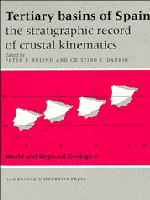Book contents
- Frontmatter
- Contents
- List of contributors
- Preface
- Dedication to Professor Oriol Riba IArderiu
- Memorial, Etienne Moissenet 1941–1994
- PART G GENERAL
- PART E EAST
- PART W WEST
- PART C CENTRE
- PART S SOUTH
- S1 The Betic Neogene basins: introduction
- S2 Neogene palaeogeography of the Betic Cordillera: an attempt at reconstruction
- S3 Depositional model of the Guadalquivir – Gulf of Cadiz Tertiary basin
- S4 Late Neogene depositional sequences in the foreland basin of Guadalquivir (SW Spain)
- S5 Miocene basins of the eastern Prebetic Zone: some tectono sedimentary aspects
- S6 Stratigraphic architecture of the Neogene basins in the central sector of the Betic Cordillera (Spain): tectonic control and base-level changes
- S7 Pliocene–Pleistocene continental infilling of the Granada and Guadix basins (Betic Cordillera, Spain): the influence of allocyclic and autocyclic processes on the resultant stratigraphic organization
- S8 Late Neogene basins evolving in the Eastern Betic transcurrent fault zone: an illustrated review
- S9 Tectonic signals in the Messinian stratigraphy of the Sorbas basin (Almeria, SE Spaín)
- S10 Basinwide interpretation of seismic data in the Alborán Sea
- Index
S3 - Depositional model of the Guadalquivir – Gulf of Cadiz Tertiary basin
Published online by Cambridge University Press: 04 August 2010
- Frontmatter
- Contents
- List of contributors
- Preface
- Dedication to Professor Oriol Riba IArderiu
- Memorial, Etienne Moissenet 1941–1994
- PART G GENERAL
- PART E EAST
- PART W WEST
- PART C CENTRE
- PART S SOUTH
- S1 The Betic Neogene basins: introduction
- S2 Neogene palaeogeography of the Betic Cordillera: an attempt at reconstruction
- S3 Depositional model of the Guadalquivir – Gulf of Cadiz Tertiary basin
- S4 Late Neogene depositional sequences in the foreland basin of Guadalquivir (SW Spain)
- S5 Miocene basins of the eastern Prebetic Zone: some tectono sedimentary aspects
- S6 Stratigraphic architecture of the Neogene basins in the central sector of the Betic Cordillera (Spain): tectonic control and base-level changes
- S7 Pliocene–Pleistocene continental infilling of the Granada and Guadix basins (Betic Cordillera, Spain): the influence of allocyclic and autocyclic processes on the resultant stratigraphic organization
- S8 Late Neogene basins evolving in the Eastern Betic transcurrent fault zone: an illustrated review
- S9 Tectonic signals in the Messinian stratigraphy of the Sorbas basin (Almeria, SE Spaín)
- S10 Basinwide interpretation of seismic data in the Alborán Sea
- Index
Summary
Abstract
The Gualdalquivir–Gulf of Cádiz Neogene Basin started to form at the end of the Early Miocene compressional phase in the Betic System. Seven stratigraphic sequences are identified in the Basin: 1–3. Preolistostromic sequences (Atlantida Group), Al, A2 and A3; 4. Synolistostromic sequence (Betica Sequence); 5. Andalucia sequence; and 6–7. Post-erosional phase sequences (Marismas and Odiel).
Introduction
After the Early Miocene Betic compressional phase, an extensional period began, affecting the Guadalquivir Valley and the Gulf of Cadiz area (Fig. 1) and forming a Neogene foreland basin with the following general characteristics:
– Langhian to Quaternary sediments infilling a WSWENE basin widening and deepening to the west.
– A passive margin to the north, resting on a Paleozoic basement and a residual Mesozoic platform.
– An active margin to the south, which is compressional and gravitational, with a large olistostromic mass infilling this side of the basin during Late Tortonian times, partly destroying and masking the previous sediments of this margin. Some olistostromic events have been reported before that time, but they are less important than the Late Tortonian gravitational advance.
The main tectonic phase affecting the basin shape occurred during the Late Miocene, when downwarping of the basement took place in the south followed by the extension of a system of faults. These processes created an important trough where a thick sedimentary sequence quickly accumulated.
- Type
- Chapter
- Information
- Tertiary Basins of SpainThe Stratigraphic Record of Crustal Kinematics, pp. 330 - 338Publisher: Cambridge University PressPrint publication year: 1996
- 24
- Cited by



